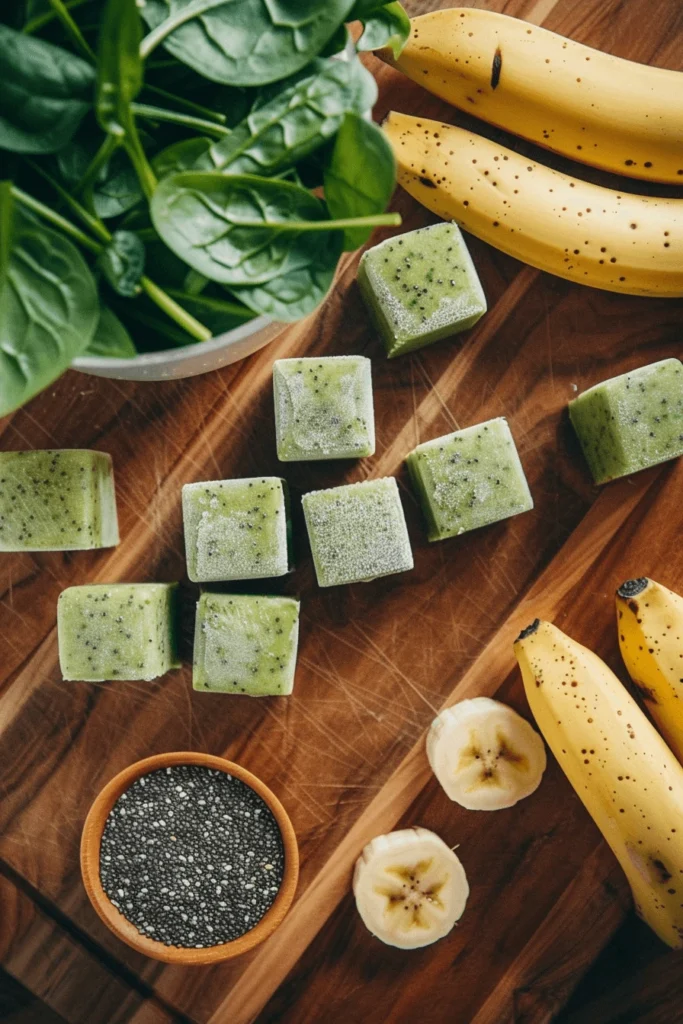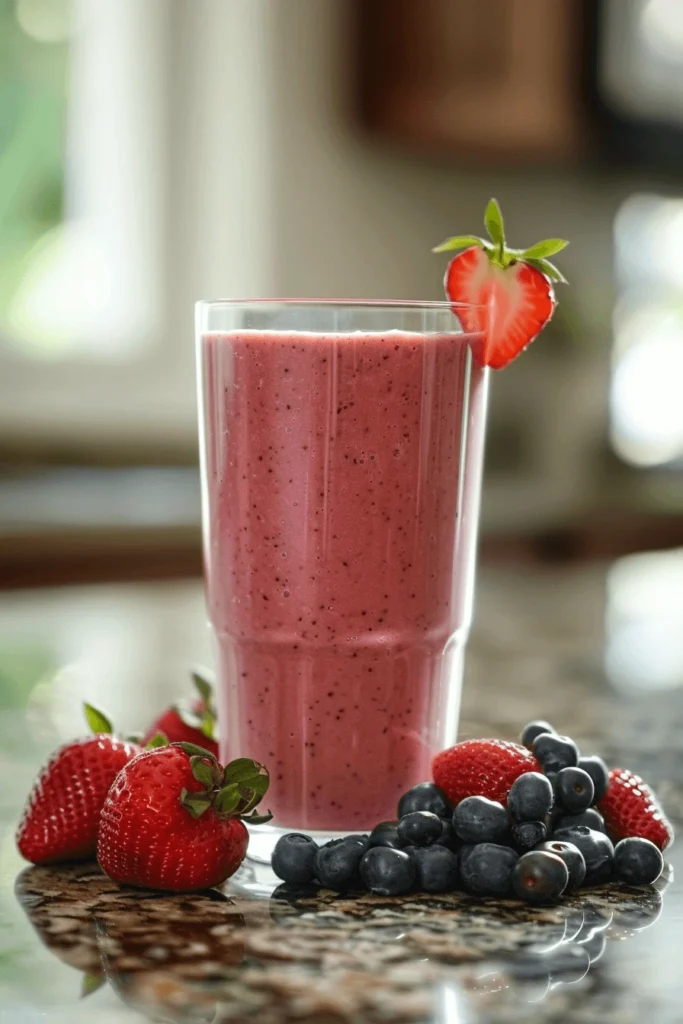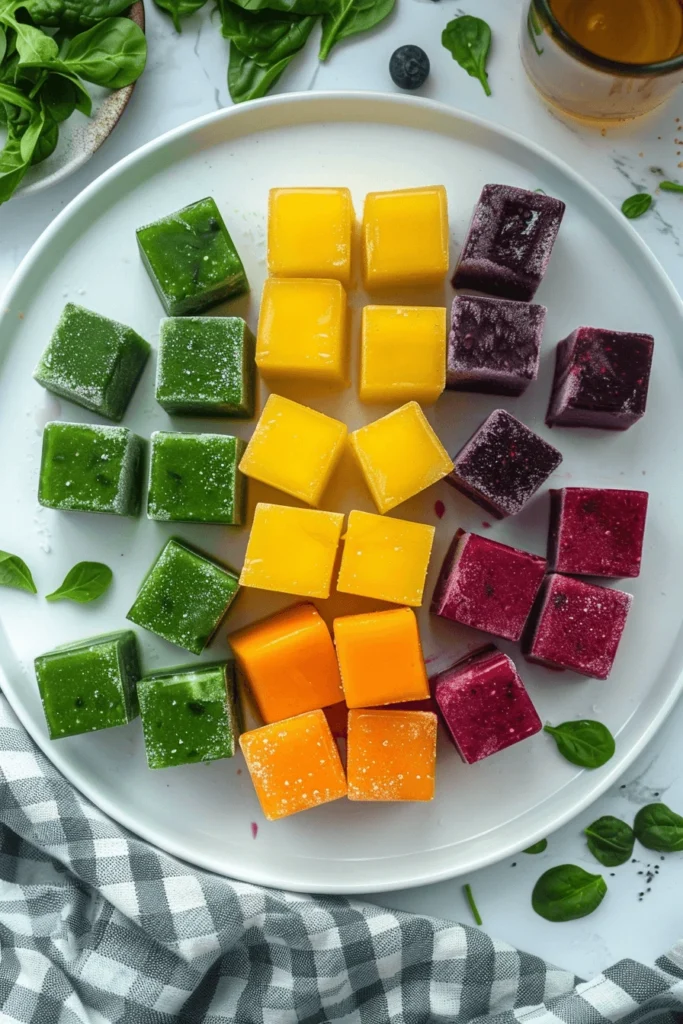There’s something oddly satisfying about tossing a colorful little cube into a blender and watching it turn into a refreshing drink. That’s the magic of smoothie cubes. Imagine prepping once and sipping for weeks — no more rushing to peel bananas at 7 a.m. or digging frozen fruit out of a rock-hard bag with a spoon that looks like it’s been through war. Instead, you just grab a few smoothie cubes, blend, and voilà: instant breakfast or snack with zero fuss. Whether you’re into a classic fruit mix, a protein smoothie cubes recipe for post-workout fuel, or even smoothie cubes no blender (yep, just stir them into a glass of milk or juice), these little frozen blocks are pure convenience.
Stick around and we’ll dig into everything from “how much of a smoothie should you drink a day?” to “are frozen fruit smoothies healthy?” with a sprinkle of humor and a whole lot of practical tips.
Print
Smoothie Cubes
- Total Time: 4 hours 10 minutes
Ingredients
1 cup spinach or kale
1 banana (ripe)
1 cup frozen mango chunks
1 cup strawberries
1 cup Greek yogurt
1 tbsp chia seeds
1 cup almond milk
Instructions
Blend all ingredients until smooth.
Pour mixture into ice cube trays.
Freeze for at least 4 hours or overnight.
Pop cubes out and store in freezer bags.
To serve, blend 4–5 cubes with 1 cup milk or juice.
Notes
Try different bases like coconut water or oat milk.
Add protein powder for protein smoothie cubes.
Use airtight containers to prevent freezer burn.
- Prep Time: 10 minutes
- Cook Time: Freezing Time: 4 hours
Nutrition
- Calories: ~40 per cube
Table of Contents
What Are Smoothie Cubes and Why Are They a Game-Changer?
Understanding Smoothie Cubes
At their core, smoothie cubes are simply pre-blended mixes of fruits, veggies, and sometimes extras like yogurt or protein powder, frozen in ice cube trays. Instead of tossing a dozen ingredients into the blender every morning, you just drop a few cubes in, add liquid, and you’re good to go. Think of them as little frozen meal preps for your blender — but cuter. They’re also an answer to that eternal question, “What do I do with this half-brown banana in my fridge?”
The idea is simple but powerful: save yourself time, reduce food waste, and always have a nutritious drink on hand. Some people even use them without blending — smoothie cubes no blender works by stirring them into milk, yogurt, or even hot oatmeal for a flavor boost.
History of Frozen Smoothie Prep
The concept isn’t brand new. People have been freezing puréed fruits and vegetables for decades, but branding them as smoothie cubes recipe has made them trendy. The rise of meal prep culture and busy morning schedules pushed these icy gems into the spotlight. Unlike single-use store-bought packs (which can get pricey), homemade smoothie cubes let you control ingredients, flavor, and nutrition.
Why They Save You Time and Money
Here’s the real kicker: smoothie cubes mean less waste. That bag of spinach threatening to wilt in your fridge? Blend it, freeze it, and drop a cube or two into your next green smoothie. That tray of overripe strawberries? They’re destined to become the star of your breakfast.
Time-wise, prepping smoothie cubes once a week takes less than an hour, and then you’ve got instant smoothies ready to go. Financially, they beat the $7 smoothies from your local café, and since you control the recipe, you can make anything from protein smoothie cubes for post-gym recovery to dessert-inspired versions for a late-night treat.
And let’s be real: there’s something satisfying about opening your freezer to a tray of colorful little blocks. It feels like snack prep meets art project — and all it takes is a blender, some fruit, and a bit of freezer space.
How to Make the Perfect Smoothie Cubes Recipe
Choosing the Best Fruits and Veggies
The beauty of a smoothie cubes recipe is flexibility. You don’t need a fancy shopping list — just work with what’s fresh, ripe, or hanging around in your fridge. Bananas are the classic base because they freeze well and add natural creaminess. Berries bring antioxidants and a bright color punch. Leafy greens like spinach or kale are sneaky ways to add nutrients without overpowering the taste. For something sweeter, pineapple and mango cubes make every sip taste like a mini vacation.
If you want a stronger nutrition boost, add carrots, beets, or even zucchini. Don’t worry — your taste buds won’t notice much, but your body definitely will. The key is mixing flavors that balance out: sweet fruits for natural sugar, veggies for fiber, and maybe a dash of spice like ginger or cinnamon to keep things interesting.

Adding Protein for Protein Smoothie Cubes
One of the easiest ways to make your cubes more satisfying is by turning them into protein smoothie cubes. Add a scoop of protein powder, Greek yogurt, or even nut butter before freezing. These extras transform a basic fruit smoothie into a meal-worthy drink that keeps you full longer.
Protein cubes are especially handy for workouts. Pop three or four into almond milk after exercising, and you’ve got a post-gym shake ready in under a minute. For those who prefer plant-based options, hemp seeds, chia seeds, or pea protein powder all freeze beautifully into cubes.
Creative Liquid Bases for Extra Flavor
Most people default to water or milk, but you can get creative with your liquid base. Coconut water adds electrolytes, oat milk brings a creamy vibe, and fresh orange juice makes every sip taste like sunshine. If you’re aiming for gut health, add kefir or a splash of kombucha.
A pro tip? Don’t add too much liquid before freezing. Make your cubes thick, almost like baby food purée. That way, when you blend them later, you can adjust the liquid depending on whether you want a thick smoothie bowl or a lighter drink.
And here’s the fun part — you can mix and match flavors. Maybe you prep one tray of tropical cubes (pineapple, mango, coconut water) and another of green cubes (spinach, banana, almond milk). Blend them together, and you’ve basically created your own café-style layered smoothie without the $8 price tag.
Adding chia seeds to your smoothie cubes is a great way to boost the nutritional value. If you’re looking for more creative ways to enhance your smoothies, check out our guide on chia seeds in fruit smoothies.
Essential Tools and Techniques
Do You Really Need a Blender? (Smoothie Cubes No Blender)
The obvious choice for using smoothie cubes is a blender, but let’s be honest — sometimes you don’t want to drag it out, wash all the parts, and then pretend you enjoyed the cleaning more than the smoothie. Luckily, there’s such a thing as smoothie cubes no blender. You can drop a couple of cubes into a mason jar with milk, shake it hard, and let the cubes slowly melt into a drinkable mix.
Another trick? Stir them into yogurt for an instant flavor upgrade, or drop one into a bowl of warm oatmeal for a fruity swirl. The point is, while a blender is the gold standard, smoothie cubes are versatile enough to work without one.
Best Storage Containers and Ice Cube Trays
Not all ice cube trays are created equal. If you’re making smoothie cubes regularly, silicone trays are the best bet — they’re flexible and make popping cubes out a breeze. Plus, they come in different sizes. Small cubes melt faster, while jumbo cubes pack more nutrition into a single block.
For storing, airtight freezer bags or glass jars are your friends. Always label your bags with the date and ingredients, because after a few weeks you won’t remember if that green cube is spinach-banana or kale-pineapple. Freezer burn is the enemy, so try to use your cubes within a month for the best taste and texture.
Tips to Keep Them Fresh and Flavorful
Here’s the secret to keeping your cubes fresh: freeze in layers. Blend your ingredients, fill half the tray, freeze, then top it up with another flavor for a two-tone cube. This keeps things interesting and helps avoid flavor fatigue.
Another pro move is flash-freezing. Spread your purée on a baking sheet in small dollops, freeze until solid, and then transfer to bags. This keeps cubes from sticking together in a giant frozen brick.
Finally, think about portioning. A standard smoothie usually takes 4–6 cubes, depending on their size. That makes it easy to customize your drink: 2 cubes for a quick snack, 6 cubes for a full breakfast. No more guessing — just cube, blend, sip, and go.
For those who love a tropical twist, incorporating coconut into your smoothie cubes is a delicious option. You can find more coconut-based recipes, like this refreshing coconut smoothie, to inspire your next blend.
Health Benefits of Smoothie Cubes
Nutritional Boost from Fruits and Greens
One of the biggest perks of smoothie cubes is how much nutrition they pack into such a small package. Every frozen cube can hold a mix of fruits, vegetables, seeds, and even proteins. When blended, they become a fast way to hit your daily fruit and veggie goals without the fuss of chopping and prepping each morning. For example, spinach or kale cubes are loaded with vitamins A, C, and K, while berry cubes bring antioxidants that help fight inflammation. Pair them with a nut butter base, and you’re adding healthy fats that keep you feeling satisfied longer.
Smoothie cubes also help reduce food waste. Instead of tossing wilted greens or overripe fruit, you freeze them into cubes for later. It’s a sustainable way to keep your diet nutrient-dense without relying on pricey supplements.
When Should You Drink a Smoothie? Morning vs. Evening
The “best time” to drink smoothies depends on your lifestyle. Many people swear by a morning smoothie because it’s quick, energizing, and easy on the stomach. A couple of protein smoothie cubes blended with almond milk can give you a steady start without the mid-morning crash.
But smoothies aren’t just for breakfast. Drinking one in the afternoon can fight off that 3 p.m. slump. Evening smoothies work too, especially if you keep them light with greens, berries, and coconut water. If you’re working out, smoothies are excellent post-exercise recovery fuel.
So really, the question isn’t when should you drink a smoothie but what type of smoothie should you drink at different times of day. Heavy, protein-rich cubes for breakfast or post-gym, lighter fruit-forward cubes for snacks, and veggie-packed blends for evening balance.
Balancing Smoothies with Daily Diet Needs
Here’s the honest truth: while smoothies are healthy, they can’t replace every meal — unless they’re carefully balanced. A smoothie made only with fruit might give you a quick sugar spike, while one with leafy greens, proteins, and healthy fats will keep your energy steady. That’s why smoothie cubes recipe prep is so helpful: you can build different sets of cubes for different nutritional goals.
For example:
- Energy boost cubes: Banana + oats + almond milk.
- Immune support cubes: Citrus fruits + ginger + spinach.
- Weight management cubes: Berries + Greek yogurt + chia seeds.
It’s all about variety and balance. With the right mix, smoothie cubes can easily become one of the healthiest (and tastiest) parts of your day.
Are Frozen Fruit Smoothies Healthy?
Comparing Fresh vs. Frozen Produce
One common question is whether frozen fruit is as healthy as fresh. The short answer: yes. In fact, frozen fruit is often picked and frozen at peak ripeness, which locks in nutrients. Fresh produce, on the other hand, can lose vitamins as it sits on shelves or in your fridge for days. When you use smoothie cubes recipe methods, you’re essentially preserving nutrition at its freshest point.
For those worried that frozen fruit lacks taste or texture, blending them into smoothie cubes actually makes them creamier and easier to work with. The bonus? They’re available year-round and often cost less than fresh fruit, especially out of season.

Does Blending Fruit Increase Sugar?
Here’s a big myth: blending fruit somehow makes it “sugarier.” In reality, blending doesn’t increase sugar — it just changes how your body digests it. Eating a whole apple means you’re chewing and slowing down the absorption of natural sugars, while drinking it in a smoothie means your body absorbs those sugars faster.
That’s why it’s smart to balance fruit with fiber, protein, and healthy fats in your smoothie cubes. For example, toss in flax seeds, chia seeds, or spinach along with fruit. That way, your blood sugar stays steady instead of spiking.
So, does blending fruit increase sugar? Technically, no — it just makes it easier for your body to access the sugar. The real trick is what you pair it with.
Debunking Myths About Smoothies and Sugar
Another myth is that smoothies are “just sugar bombs.” Sure, if you’re blending six bananas and a glass of juice, that’s a lot of sugar. But the beauty of protein smoothie cubes or veggie-rich blends is balance. You control the ratios.
Think of smoothie cubes as customizable nutrition. Want low sugar? Use more greens and nut butters. Need energy before a workout? Opt for berries and oats. Wondering how much of a smoothie should you drink a day? Usually one smoothie a day is perfect — it adds nutrients without overloading your diet.
At the end of the day, smoothies are only as healthy as the ingredients you put in. With a smart balance, frozen fruit smoothies aren’t just healthy — they’re one of the easiest ways to make sure your body gets the good stuff daily.
Practical Tips for Using Smoothie Cubes Daily
Portion Control: How Much of a Smoothie Should You Drink a Day?
One of the top questions people ask is, “How much of a smoothie should you drink a day?” The sweet spot is usually one smoothie a day. That’s enough to load up on nutrients without overdoing calories or natural sugars. A typical serving is 8–12 ounces, which equals about 4–6 smoothie cubes depending on their size. If you’re replacing a meal with a smoothie, make it a bit larger and add protein or healthy fats to keep you full.
The beauty of smoothie cubes is precision. Instead of eyeballing fruit or protein scoops every morning, you just count your cubes. Want a snack? Use two. Need breakfast? Use six. The math couldn’t be easier.
Mixing Smoothie Cubes with Other Ingredients
While smoothie cubes are great on their own, they also play well with other ingredients. For example, you can blend two protein smoothie cubes with almond milk, then toss in some oats for a more filling breakfast. Or you can add cocoa powder and peanut butter for a dessert-like drink that’s secretly nutritious.
If you’re more into variety, pair different cube types together. A tropical pineapple-mango cube mixes beautifully with a spinach-banana cube. Not only do you get different flavors, but you also get a more balanced nutrient profile.
And if you’re short on time, remember the smoothie cubes no blender trick: stir them into yogurt, let them melt into overnight oats, or shake them in a jar of milk for a quick on-the-go drink.
Kid-Friendly and On-the-Go Ideas
Smoothie cubes aren’t just for adults. Kids love the bright colors and fun flavors. Try making strawberry-banana cubes for after-school snacks or sneaking in a few spinach cubes to boost their veggie intake without a battle.
For busy mornings, prep smoothie jars the night before: drop 5–6 cubes into a mason jar, top with your liquid of choice, and leave it in the fridge. By the next morning, you’ll have a ready-to-drink smoothie waiting.
For on-the-go lifestyles, smoothie cubes also double as ice packs. Toss a few into a water bottle or protein shaker before heading out. By the time you’re ready to drink, the cubes will have melted into a refreshing, nutrient-packed beverage.
Creative Smoothie Cube Recipes
Tropical Escape Cubes
If your taste buds are craving sunshine, tropical smoothie cubes recipe is the answer. Blend pineapple, mango, banana, and coconut water, then freeze into cubes. These cubes scream vacation-in-a-glass. Drop four cubes into almond milk, and you’ll instantly feel like you’re sipping on the beach.
For an extra protein kick, add a scoop of vanilla protein powder before freezing. That turns these cubes into protein smoothie cubes perfect for post-workout recovery.
Green Power Cubes
For those who want energy without relying on coffee, green cubes are your secret weapon. Mix spinach, kale, banana, green apple, and oat milk, then pour into trays. Add a touch of ginger for zing.
These cubes pack in vitamins, minerals, and fiber, making them ideal for mornings when you need a natural energy boost. Blend them with coconut water for hydration or stir a cube into your morning oatmeal if you’re going the smoothie cubes no blender route.

Dessert-Inspired Smoothie Cubes
Who said smoothies can’t feel like dessert? Try a chocolate-peanut butter version: banana, cocoa powder, peanut butter, and Greek yogurt. Freeze them, and you’ve got cubes that taste like a milkshake but deliver protein and nutrients.
Another crowd-pleaser? Strawberry cheesecake cubes. Blend strawberries, Greek yogurt, oats, and a splash of vanilla extract. Drop a few into milk, blend, and you’ve got a treat that feels indulgent without the sugar crash.
To elevate your smoothie cubes, consider adding a spoonful of homemade fruit compote. For a berry-packed option, our blueberry compote recipe is a perfect addition.
FAQs Answered
What do you do with smoothie cubes?
You can blend them with your favorite liquid for an instant smoothie, stir them into yogurt, or even melt them into oatmeal for added flavor. If you’re on the go, just drop a few into a shaker bottle with milk, give it a shake, and you’ve got a quick drink.
Do smoothie cubes work?
Yes — and beautifully. Smoothie cubes save you prep time, reduce food waste, and guarantee you always have a healthy option ready. They’re portion-controlled, versatile, and customizable, which makes them practical for everyday use.
Is it healthy to drink a smoothie daily?
Absolutely, as long as it’s balanced. A daily smoothie made with fruits, vegetables, protein, and healthy fats can be a nutrient powerhouse. The key is avoiding sugar-heavy recipes. That’s why having a smoothie cubes recipe with greens and proteins is smarter than just fruit alone.
Can I just drink smoothies instead of eating?
Technically, yes — but it depends on the ingredients. A smoothie with only fruit won’t keep you full for long. If you’re considering replacing meals, make sure your smoothie includes protein, fiber, and healthy fats. Protein smoothie cubes are excellent for this because they add staying power to your drink.
Does blending fruit increase sugar?
Blending doesn’t create extra sugar — it just changes how your body processes it. The natural sugars in fruit become easier to absorb when blended. The solution is balance: pair fruits with fiber-rich ingredients (like oats or chia) or proteins (like yogurt or nut butter) to slow digestion and keep blood sugar stable.
Conclusion and Final Thoughts
Why Smoothie Cubes Deserve a Spot in Your Freezer
In a world where mornings are rushed, afternoons drag, and evenings sometimes call for comfort food, smoothie cubes step in as a simple, healthy solution. They’re quick, versatile, and customizable — whether you’re throwing together a tropical escape blend, sneaking greens into your diet, or whipping up protein smoothie cubes after a workout.
Quick Recap of Benefits and Best Practices
- Convenience: Prep once, enjoy all week.
- Health: Pack in fruits, veggies, proteins, and healthy fats.
- Flexibility: Use them in smoothies, yogurt, oatmeal, or even shakes without a blender.
- Sustainability: Cut food waste by freezing produce before it spoils.
And yes, you now know how much of a smoothie should you drink a day, whether are frozen fruit smoothies healthy, and even if does blending fruit increase sugar. Spoiler: smoothie cubes come out on top every time.
Encouragement to Experiment with Your Own Recipes
At the end of the day, smoothie cubes are about making life easier and healthier while keeping flavors fun. So grab your favorite tray, toss in some fruit and greens, and start experimenting. You’ll soon find that your freezer full of colorful little cubes is more exciting than a shelf full of supplements.
Find more delicious recipes on DifferentyRecipes Pinterest, and stay inspired with the newest tips and ideas by following DifferentyRecipes on Facebook.
